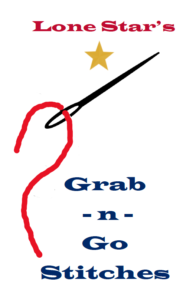
edited by Sue Ella Allen and John Waddell, Lone Star ANG, 2019
Premiering at the recent ANG Seminar, this compilation of over 450 stitches was collected by the Lone Star Chapter of ANG and edited by two of their members. It’s put together in a very handy format, the same size as Stitches to Go, fitting nicely in your project bag. It’s also spiral-bound so it can lay flat next to you as you refer to the stitch.
The book is the result of a year-long project by the chapter. At each meeting members were encouraged to bring in hand-drawn charts of their favorite stitches. The editors went through the results and removed those stitches that were already in Stitches to Go, leaving us with a book that has all new stitches.
The book is organized differently from most stitch books, by overall stitch direction. You’ll find chapters on stitches that read straight, diagonal, and oblique. There are also chapters on leaf stitches, laid fillings, blackwork, and darning patterns. I love this way of organizing. When we pick stitches for a project all too often we ignore the direction of the stitch pattern and only think about the stitch family. This can easily result in a mismatch between the item and the stitch. By considering the direction of the pattern, this will rarely happen.
For the majority of the stitches you can easily tell the direction of the pattern in the diagram. The stitches in each chapter are organized from stitches to use in small areas to stitches for large areas. The stitches in each chapter cover different stitch families.
This book is what I call a “just the facts ma’m” stitch dictionary. The diagrams are presented with no names and no stitch numbers. In the text at the end of the book, the editors explain, quite correctly, that names differ for the same stitch, and that stitchers should create paths to make a stitch that make sense to them. Sensibly enough they suggest that the stitcher make a copy of the diagram and number and/or color it for their own use.
The diagrams are clear and easy to read. A few of the diagrams have a second color. This is the only fault I found with the book. For a second color two shades of grey were used. One is easy to see. The other is so light that I wasn’t even sure it was there. But this problem affects very few diagrams in the book.
Very intriguing are the last two chapters. Laginappe has a variety of useful patterns for commonly found areas: one- and two-intersection spaces, straight one- and two-thread straight lines. narrow diagonal lines, and what I’d call chaotic patterns wher the stitches combine oblique and diagonal stitches slanting in many directions (these would be amazing for water). The last chapter, Tips & Tricks, explains serveral things. The choices of the editors are explained, along with how you can use the book. There is also an incredibly useful section on mirroring and flipping stitches, including step-by-step instructions on doing this in Word.
I am so excited about this book. It has so many fantastic stitches that I can’t wait to start using them in my upcoming projects. Since I’m starting a new project today, I’m planning on using this book. It’s going in the big tote I keep by my stitching chair as one of my constant referral books.
Getting your Copy
The book is currently available from Houston area needlepoint shops. It will be distributed to shops nationwide soon. To learn more about getting copie, visit the Lone Star Chapter’s site for the book. There you will find a list, with phone numbers, of Houston shops and information about getting wholesale information.
Please note: A copy of this book was provided to me for review purposes, but I would buy it in a second, and you should too!
About Janet M Perry
Janet Perry is the Internet's leading authority on needlepoint. She designs, teaches and writes, getting raves from her fans for her innovative techniques, extensive knowledge and generous teaching style. A leading writer of stitch guides, she blogs here and lives on an island in the northeast corner of the SF Bay with her family

Hi Janet,
I don’t quite understand what you are saying about this book (and I’m probably wrong).
The stitches have nome names on them?
Could you please help me understand this a little better.
Thank you,
Mary Beth Oles
Many books give names to stitches, but there is no standard for naming. In this case the editors decided not to give the stitches names.
Keep stitching,
Janet